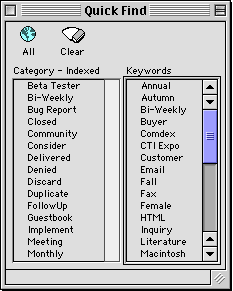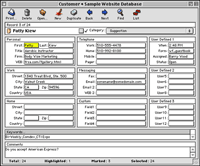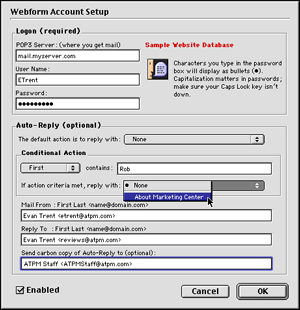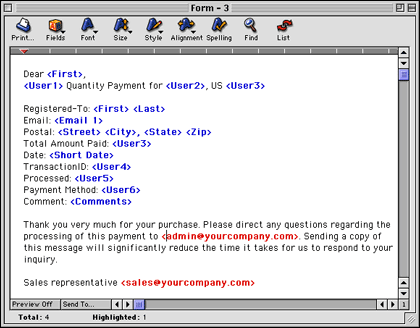Review: Document Express 2.5

Product Information
Published by: Document Express Inc.
Web: http://www.documentexpress.com
E-Mail: sales@documentexpress.com
Requires: System 7.5 or better, 2 MBs of hard drive space, 4 MBs of RAM, 68030 processor or later (runs native on PPC), Internet Access
Price: $150 (through August 1999); $250 full version w/ box, CD, manual, shipped to buyer; $200 download version, activated with serial number
Reminiscing DE
Back when Document Express 1.0 was first released, I reviewed it in ATPM 4.05. My general reaction to version 1.0 was that it showed a tremendous amount of promise but was rough around the edges and lacked focus. Upon publication of 4.05, Mark Teixeira, the developer of DE, contacted me and voiced a genuine interest in implementing some of my ideas in a future release. Subsequently Document Express 2.0 was released, and then at Macworld Expo NY, version 2.5 was released. I am happy to report that Document Express has blossomed into the program I had hoped it would and is now a tremendously useful suite for a variety of applications.
From its inception, DE offered wonderfully simplistic and flexible bulk e-mail capabilities, and thanks to a Fax STF plug-in, it offered bulk faxing abilities as well. But DE was bogged down by some interface quirks and contact management limitations. DE also lacked adequate focus. It seemed as if it was trying to do too much and wasn’t limiting its scope to performing a particular set of tasks exceptionally well.
DE’s Definitive Development
 Version 2.5 has remedied a number of my initial complaints with respect to contact management. There are now twelve custom fields, rather than eight, and a contact’s first and last names may be viewed together in one column, saving space, which can be used to display other information. Similarly, Custom fields may now have a list of values which may be chosen from a pop-up menu. A Quick Find feature has been added, and it responds dynamically, which is slick. As before, Find and Replace is a welcome feature, but the Find provisions remain a bit wimpy. However, the Customer menu has a number of new additions which are very useful and bolster the contact management feature set.
Version 2.5 has remedied a number of my initial complaints with respect to contact management. There are now twelve custom fields, rather than eight, and a contact’s first and last names may be viewed together in one column, saving space, which can be used to display other information. Similarly, Custom fields may now have a list of values which may be chosen from a pop-up menu. A Quick Find feature has been added, and it responds dynamically, which is slick. As before, Find and Replace is a welcome feature, but the Find provisions remain a bit wimpy. However, the Customer menu has a number of new additions which are very useful and bolster the contact management feature set.
Interface issues have been resolved as well. Page-Up and Page-Down now work properly in List view, as do Home and End. DE now offers better Drag Manager support. For example, a contact may be dragged in list view to the Finder and a clipping will be formed containing the postal address. Likewise a contact may be dragged into any text editor and the address will be inserted. As nice as this is, DE doesn’t support dragging data into any of its fields in Entry mode. It would be nice if text could at least be dragged into the Comment field. DE does offer the XTractor plug-in which enables the user to extract an e-mail address from any text dragged into the XTractor window. Thanks to DE’s SDK a more sophisticated version of XTractor could be written, but we’ll save that for later.
A Few Bugs to Squash
Some interface quirks remain. The biggest problem is that the Entry window behaves strangely in certain situations. For example, there are three columns of fields in Entry mode. However, if the window is resized such that it is too narrow to display all three columns, there is no horizontal scroll bar and hence data can not be read from or entered into those fields. Tabbing to them does not help. Similarly, a window can be resized so that only part of the third column of fields is visible.
 While DE does offer four different window sizes (Micro, PowerBook, Classic and Standard), these views merely affect the number of rows of fields, not the number of columns. What DE should do is prevent the user from shrinking the width of the window beyond a certain point, hence preventing the problem of non-visible entry fields. In DE’s defense, however, window sizes have all be designed to fit perfectly on a 640 pixel wide screen. Hence the solution is to simply keep the window wide enough such that all three columns of fields are visible, and most any screen these days should be able to accommodate that.
While DE does offer four different window sizes (Micro, PowerBook, Classic and Standard), these views merely affect the number of rows of fields, not the number of columns. What DE should do is prevent the user from shrinking the width of the window beyond a certain point, hence preventing the problem of non-visible entry fields. In DE’s defense, however, window sizes have all be designed to fit perfectly on a 640 pixel wide screen. Hence the solution is to simply keep the window wide enough such that all three columns of fields are visible, and most any screen these days should be able to accommodate that.
There are some additional interface quirks remaining. In certain dialog boxes, Shift-Tab does not function as it should, moving the cursor into the previous entry field; rather it functions as Tab does, moving the cursor to the next entry field. This is odd because Shift-Tab and Tab work properly in the Entry view. Granted these complaints are petty and generally speaking, DE is compliant in terms of Mac OS interface standards and guidelines. The List display is wonderfully up to date with the Mac OS, in contrast to older contact management applications. DE is also quite fast, which is a refreshing change from many older contact management applications as well. Overall if your needs are modest, DE should double as both a bulk communications tool and an adequate contact manager.

A New Lease on Life
 In terms of focus, DE has come a long way, redefining its purpose and narrowing its scope. Since version 1.0, Webforms has been added. Webforms, which build on the concept of Mailforms, are essentially an automated method of responding to HTML forms. DE includes a CGI (to be placed on a Web server) which will e-mail the results of a form to a user-defined address. DE will monitor that e-mail box for incoming e-mail, deal with the data from the e-mail, merge it into a DE contact database, and optionally auto-respond to incoming e-mails. Responses may be conditional or unconditional. DE will, of course, customize the auto-reply appropriately using the information it received in the e-mail. The concept is simple enough but the possibilities are endless thanks to DE’s magnificently robust implementation.
In terms of focus, DE has come a long way, redefining its purpose and narrowing its scope. Since version 1.0, Webforms has been added. Webforms, which build on the concept of Mailforms, are essentially an automated method of responding to HTML forms. DE includes a CGI (to be placed on a Web server) which will e-mail the results of a form to a user-defined address. DE will monitor that e-mail box for incoming e-mail, deal with the data from the e-mail, merge it into a DE contact database, and optionally auto-respond to incoming e-mails. Responses may be conditional or unconditional. DE will, of course, customize the auto-reply appropriately using the information it received in the e-mail. The concept is simple enough but the possibilities are endless thanks to DE’s magnificently robust implementation.
The CGI included with DE was written in Perl and designed to run on a UNIX based Web server. It is based on the FormMail CGI, written by Matt Wright of Matt’s Script Archive fame. FormMail (which we use here at ATPM ) is accepted by most as the best CGI of its kind (as are most of Matt’s scripts) and hence was a good choice on DE’s part.

Also included is a sample Web site which a user can base his or her own site upon. A number of sample HTML forms are included, all of which engage the CGI, pass the proper parameters and data, and mail the data to the e-mail address specified in the HTML form. DE can then check the POP box for that e-mail address, retrieve the data, merge it into the name of the file specified in the HTML form, and then auto-reply appropriately. This technology provides far more flexibility than an auto-responder and for obvious reasons is more efficient and cost effective than paying an employee to manually enter information received from an e-mail.
Document Express also offers additional functionality thanks to the Serializer plug-in, which enables a software developer to use DE to respond to customer registration forms with a serial number, which is appropriately calculated. The source code to this plug-in is included such that a software developer may simply punch in his algorithm for serial number generation and then DE will spit out properly formatted serial numbers automatically. This is a truly cool feature.
DE’s new feature set gives it greater focus and minimizes the impact of limited abilities such as envelope printing, etc. Previously, DE presented itself as a bulk e-mailer and contact management combination, but now it is obvious that DE’s selling point is bulk, automated, personalized communication. Contact management is merely an organizational tool rather than a main objective. The ability to export and import contacts allows a user to retain his or her favorite choice of contact manager should DE not suffice.
A Superb SDK
Since my review of Document Express 1.0, I had the opportunity to investigate the DE SDK, which enables a programmer to write a plug-in module for DE. Having researched this SDK and subsequently written an article for MacTech (March ’99) based upon my discoveries, I can report that the SDK is exceptionally well designed and thought out. Programming a plug-in for DE is quite simple, provided a solid understanding of C++ and the Mac OS in general.
The Final Word
Document Express has blossomed into an awesome integrated suite, facilitating bulk customized communication by e-mail and fax, automated database entry based on HTML form submission, automated customized response to HTML form submission, and even serialization. For a small software developer or other entrepreneur, it is an invaluable tool.
The inclusion of a snazzy sample Web site will be much appreciated by those who are unfamiliar with HTML and CGI related issues. Mark Teixeira has even negotiated special Web hosting prices with a Mac based ISP and has more deals in the works for his customers. While DE still could use a bit of smoothing over, as usual my complaints are the result of my perfectionist nature.
Considering its offerings (which I might add are unavailable in any other software package), Document Express is an outstanding product that is now well worth its $149 price tag. Furthermore, Mark Teixeira has proven himself a dedicated and driven Macintosh developer and has included an excellent manual to accompany version 2.5. Add it all up and you end up with a robust and flexible application which manages electronic communications superbly.
Reader Comments (0)
Add A Comment